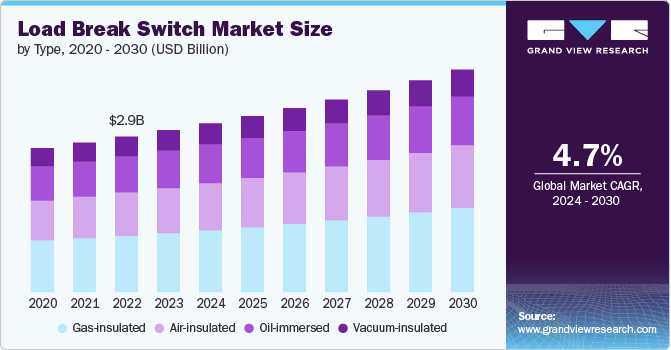Load Break Switch Market Size, Share & Trends Analysis grow at a CAGR of 4.7% from 2024 to 2030

The global load break switch market size was estimated at USD 2.98 billion in 2023 and is projected to grow at a CAGR of 4.7% from 2024 to 2030. Rapid urbanization and ongoing infrastructure development across the globe significantly drive the demand for load break switches. As cities expand and new infrastructure projects emerge, the need for reliable and efficient power distribution systems becomes more critical. This growing demand for electricity necessitates advanced components such as load break switches to ensure safe and effective power distribution.
Request a free sample copy or view report summary: https://www.grandviewresearch.com/industry-analysis/load-break-switch-market-report/request/rs1
The construction of residential, commercial, and industrial buildings directly contributes to the rising need for load break switches. This trend is expected to continue as urbanization accelerates and electricity consumption increases.
The evolution of smart grid technology is another key factor fueling the growth of the market. Smart grids require advanced components to manage and control electricity distribution effectively, and load break switches play a crucial role in these systems. The growing demand for electricity, combined with the need for efficient grid management, drives the adoption of smart grids and the integration of load break switches. As smart grid technology continues to evolve, it will further boost market growth by enhancing the efficiency and reliability of power distribution networks.
The shift towards renewable energy sources, such as solar and wind power, is driving the growth of the market. Renewable energy systems require robust and reliable components to manage power distribution effectively, particularly as the demand for electricity continues to rise. Load break switches are essential in integrating these renewable energy sources into the existing power grid, ensuring safe and efficient operation. The increasing adoption of renewable energy sources, driven by the need to meet growing electricity demands sustainably, is positively impacting the market for load break switches.
Governments worldwide are implementing stringent regulations and standards to promote energy efficiency and electrical safety, which impacts the load break switch industry. These regulations often mandate the use of high-quality load break switches to ensure safe and reliable power distribution. The increasing demand for electricity amplifies the need for effective and compliant power management solutions, driving the adoption of load break switches. Compliance with these regulations not only enhances safety but also improves the efficiency of electrical systems. As regulations become more stringent, the market for load break switches is expected to grow in response to the rising electricity demand.
Technological advancements and innovations in load break switch design and functionality contribute to the market’s growth. As the demand for electricity grows, manufacturers are focusing on developing advanced switches with improved performance, durability, and features to meet the evolving needs of power distribution systems. Innovations such as remote operation capabilities, enhanced safety features, and integration with digital technologies are expanding the applications of load break switches. These advancements cater to the increasing demand for reliable and efficient power management solutions. The continuous development of new products and technologies will sustain the momentum of the market.
Type Insights
Based on type, the gas-insulated segment led the market and accounted for 36.4% of the global revenue in 2023, owing to its advanced features and superior performance they offer. The growing need for compact, efficient, and reliable power distribution solutions in urban and industrial settings where space is limited is also contributing to the growth of the segment. These switches are increasingly favored for their enhanced safety, minimal maintenance requirements, and their ability to operate effectively in high pollution or harsh environmental conditions. The demand for gas-insulated switches is also fueled by the rising focus on upgrading existing infrastructure to support modern, high-performance electrical systems.
The air-insulated segment is expected to register significant growth from 2024 to 2030. These switches are appreciated for their simplicity, cost-effectiveness, and ease of installation, making them suitable for applications where space constraints are less of an issue. Despite their advantages, air-insulated switches face competition from gas-insulated technology, which offers superior performance and reliability. The adoption of air-insulated switches can be attributed to the increasing preference for more advanced solutions that align with modern power distribution needs.






